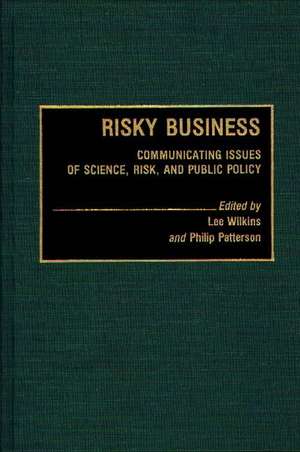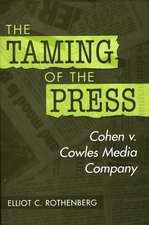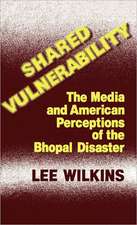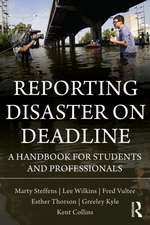Risky Business: Communicating Issues of Science, Risk, and Public Policy: Contributions to the Study of Mass Media and Communications
Autor Lillian C. Black Wilkins, Philip Pattersonen Limba Engleză Hardback – 29 mar 1991 – vârsta până la 17 ani
Din seria Contributions to the Study of Mass Media and Communications
- 27%
 Preț: 439.09 lei
Preț: 439.09 lei - 35%
 Preț: 413.28 lei
Preț: 413.28 lei - 38%
 Preț: 343.98 lei
Preț: 343.98 lei - 27%
 Preț: 345.15 lei
Preț: 345.15 lei - 27%
 Preț: 438.67 lei
Preț: 438.67 lei - 28%
 Preț: 461.28 lei
Preț: 461.28 lei - 27%
 Preț: 443.66 lei
Preț: 443.66 lei - 24%
 Preț: 464.40 lei
Preț: 464.40 lei - 28%
 Preț: 437.84 lei
Preț: 437.84 lei - 38%
 Preț: 438.67 lei
Preț: 438.67 lei - 27%
 Preț: 438.93 lei
Preț: 438.93 lei - 24%
 Preț: 462.20 lei
Preț: 462.20 lei - 24%
 Preț: 460.25 lei
Preț: 460.25 lei - 27%
 Preț: 345.15 lei
Preț: 345.15 lei - 28%
 Preț: 435.80 lei
Preț: 435.80 lei - 38%
 Preț: 437.40 lei
Preț: 437.40 lei - 27%
 Preț: 345.67 lei
Preț: 345.67 lei - 38%
 Preț: 344.63 lei
Preț: 344.63 lei - 38%
 Preț: 438.51 lei
Preț: 438.51 lei - 38%
 Preț: 346.42 lei
Preț: 346.42 lei - 28%
 Preț: 462.70 lei
Preț: 462.70 lei - 28%
 Preț: 460.93 lei
Preț: 460.93 lei - 38%
 Preț: 442.40 lei
Preț: 442.40 lei - 27%
 Preț: 638.30 lei
Preț: 638.30 lei - 38%
 Preț: 438.00 lei
Preț: 438.00 lei - 38%
 Preț: 436.73 lei
Preț: 436.73 lei - 19%
 Preț: 459.24 lei
Preț: 459.24 lei - 28%
 Preț: 437.91 lei
Preț: 437.91 lei - 24%
 Preț: 460.16 lei
Preț: 460.16 lei - 24%
 Preț: 461.35 lei
Preț: 461.35 lei - 27%
 Preț: 441.13 lei
Preț: 441.13 lei - 38%
 Preț: 437.24 lei
Preț: 437.24 lei - 38%
 Preț: 437.57 lei
Preț: 437.57 lei - 27%
 Preț: 439.44 lei
Preț: 439.44 lei - 28%
 Preț: 436.73 lei
Preț: 436.73 lei - 24%
 Preț: 363.73 lei
Preț: 363.73 lei - 24%
 Preț: 459.56 lei
Preț: 459.56 lei - 27%
 Preț: 345.30 lei
Preț: 345.30 lei - 38%
 Preț: 437.57 lei
Preț: 437.57 lei - 24%
 Preț: 364.90 lei
Preț: 364.90 lei - 33%
 Preț: 320.01 lei
Preț: 320.01 lei - 27%
 Preț: 346.25 lei
Preț: 346.25 lei - 38%
 Preț: 437.47 lei
Preț: 437.47 lei - 38%
 Preț: 436.99 lei
Preț: 436.99 lei - 38%
 Preț: 345.74 lei
Preț: 345.74 lei - 27%
 Preț: 439.09 lei
Preț: 439.09 lei - 15%
 Preț: 441.90 lei
Preț: 441.90 lei - 11%
 Preț: 460.76 lei
Preț: 460.76 lei
Preț: 438.17 lei
Preț vechi: 604.44 lei
-28% Nou
Puncte Express: 657
Preț estimativ în valută:
83.86€ • 87.22$ • 69.23£
83.86€ • 87.22$ • 69.23£
Carte tipărită la comandă
Livrare economică 15-29 aprilie
Preluare comenzi: 021 569.72.76
Specificații
ISBN-13: 9780313266010
ISBN-10: 0313266018
Pagini: 256
Dimensiuni: 156 x 235 x 16 mm
Greutate: 0.54 kg
Editura: Bloomsbury Publishing
Colecția Praeger
Seria Contributions to the Study of Mass Media and Communications
Locul publicării:New York, United States
ISBN-10: 0313266018
Pagini: 256
Dimensiuni: 156 x 235 x 16 mm
Greutate: 0.54 kg
Editura: Bloomsbury Publishing
Colecția Praeger
Seria Contributions to the Study of Mass Media and Communications
Locul publicării:New York, United States
Notă biografică
LEE WILKINS is a Professor and Associate Dean, School of Journalism, University of Missouri, Columbia. She authored Shared Vulnerability: Media Coverage and Public Perception of the Bhopal Disaster and Wayne Morse: A Bio-Bibliography (Greenwood Press, 1987 and 1985, respectively).PHILIP PATTERSON is an Associate Professor and Chair of the Communications Department, Oklahoma Christian University. He specializes in mass-media ethics, media coverage of science, and political communication. He has been published widely in various communications journals.
Cuprins
Foreword: Why Is Science Writing So Uncritical of Science? by Dorothy NelkinIntroduction by Lee Wilkins and Philip PattersonRisk Perceptions as Substance and Symbol by Robin GregoryComing to Terms with the Impact of Communication on Scientific and Technological Risk Judgments by Sharon Dunwoody and Kurt NeuwirthRisk Management: The Public Versus the Technical Experts by Sharon M. FriedmanPopularization vs. Secularization: Media Coverage of Health by Robert A. LoganThe Stigma of Mental Illness: Labeling and Stereotyping in the News by Russell E. Shain and Julie PhillipsMedia Coverage of Technoloy Issues: Ethiopian Drought of 1984, AIDS, Challenger, and Chernobyl By Everett M. Rogers and Soon Bum ChangA Cross-Societal Comparison of Disaster News Reporting in Japan and the United States by E. L. Quarantelli and Dennis WengerOrganizational Communication and Technological Risks by Phillip K. TompkinsThe Security of Secrecy by David M. RubinA Case of Need: Media Coverage of Organ Transplants by Deni ElliottScience as Symbol: The Media Chills the Greenhouse Effect by Lee Wilkins and Philip PattersonDisasters and the Making of Political Careers by Sue O'BrienConclusions by Lee Wilkins and Philip PattersonBibliographyIndex


















